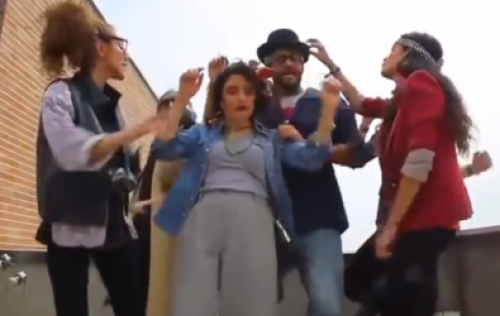A Story and a Few Simple Questions
by Yaghoub Yadali and translated by Parvaneh Torkamani. / June 13, 2014 / No comments
Getting footloose: Dancing is a crime in Iran.

Screenshot from the video that put six Iranians in police custody for dancing. Photo: Pooya Jahandar via YouTube.
In an international campaign sparked by the arrest of six students from Tehran, people around the globe (many of whom are Muslim) made videos inspired by their arrest and the Pharrell Williams song “Happy.”
- “Enemy…terrorism…nuclear bomb…war.” These words are often used by American media to describe Iran. The image the media presents is often hazy, incomplete, and distorted. The political and military aspects of my country are covered mainly in a negative light.
- In Under Eastern Eyes (I have adopted the name from the novel Under Western Eyes by Joseph Conrad), I will write about those topics which American media either cannot or does not want to talk about. The emphasis will be on social and cultural aspects of Iran although, out of necessity, I will talk about politics, despite my despair.

- Yaghoub Yadali, born in 1970, is a writer and television director. His first work of fiction, the short-story collection Sketches in the Garden, was published in 1997. It was followed in 2001 by Probability of Merriment and Mooning, which was named book of the year by the Writers and Critics Award. His first novel, The Rituals of Restlessness, won the 2004 Golshiri Foundation Award for the best novel of the year and was named as one of the ten best novels of the decade by the Press Critics Award. He has also published many articles and reviews of literature and cinema in newspapers and magazines in Iran.
A few weeks ago, the six young Iranians were arrested for making a video of themselves dancing on a rooftop to the Pharrell Williams song.
In the midst of political tensions, dancing is considered illegal in Iran. The Tehrani students’ participation in what was originally a worldwide fan response to the video for Williams’ “Happy”–in which people record themselves dancing to and lip-syncing the popular song—resulted in their arrest. Tehrani police claimed to have apprehended the young people for dancing in “inappropriate dress,” thus sparking a debate that went viral.
In a statement meant to intimidate Iranians, Tehrani Police Chief Hossein Sajedinia announced that police had identified the students within two hours after the video was posted, and had arrested them within six hours. The subsequent arrest, really for dancing and showing happiness, was covered by major media outlets around the world.
Following this, Internet users in Iran wrote hundreds of thousands of words about the students’ arrest. Pharrell Williams tweeted that he believes the six students should not be persecuted for their expression of happiness, and even Iranian President Rouhani tweeted in English, “#Happiness is our people’s right. We shouldn’t be too hard on behavior caused by joy.” President Rouhani’s statement was considered an objection to the arrest—which is significant as the Tehran police force is under conservative control.
After twenty-four hours, the young people were freed and several video clips based on the Pharrell Williams song were posted in response. In these video clips, people at home, on the street, or in parks dance and demonstrate their happiness.
In thinking about this story, a few simple questions could arise in one’s mind: If these six people weren’t criminals, why were they arrested? Why were they immediately freed? Why were the Iranians who danced in the next series of videos not arrested? Of course, the answer to the last question is obvious. Their numbers were too great.
The result of the arrest was the exact opposite of what the police wanted. In a short time, a video that, at first, had very few viewers (probably only friends of the students) received hundreds of thousands of hits and became an out-of-control act of protest.




